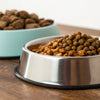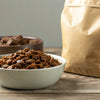Why Has My Dog Stopped Eating Dry Food? Understanding the Reasons and Solutions
- Houndsy
Table of Contents
- Introduction
- Understanding the Reasons Behind Your Dog's Disinterest
- Practical Solutions to Encourage Eating
- The Importance of Quality Food
- Conclusion
Introduction
Imagine this: it’s mealtime, and your furry friend walks up to their bowl, sniffs the dry food, and turns away. For many dog owners, this sudden change in eating behavior can be alarming. According to recent studies, about 15% of dogs experience a significant change in appetite at some point in their lives. If you're reading this, you might be wondering, why has my dog stopped eating dry food? Understanding this issue is crucial because not eating can be a sign of underlying health concerns, behavioral issues, or simply a preference for something else.
In this blog post, we will explore the diverse reasons why dogs may stop eating dry food, ranging from health-related issues to behavioral factors. We will also provide actionable insights on how to encourage your dog to eat again and when it might be critical to consult a veterinarian. By the end of this article, you’ll have a comprehensive understanding of the potential causes and solutions to help your beloved pet enjoy their meals once more.
With this in mind, let’s embark on this journey to uncover the reasons behind your dog’s sudden pickiness and explore how we can make feeding time a delightful experience for both of you.
Understanding the Reasons Behind Your Dog's Disinterest
Medical Issues
1. Dental Problems
One of the most common medical reasons dogs stop eating is dental pain. If your dog is experiencing discomfort from tooth decay, gum disease, or a broken tooth, they may avoid dry food, which requires more chewing. Signs of dental issues include bad breath, swollen gums, or difficulty chewing. If you suspect dental pain, it's essential to consult with your veterinarian for a thorough examination.
2. Gastrointestinal Upset
Just like humans, dogs can suffer from stomach issues that may make them reluctant to eat. Nausea, for instance, can stem from various causes including dietary indiscretion, infections, or even motion sickness. Look for signs such as drooling, lethargy, or vomiting, which may indicate an upset stomach.
3. Serious Health Conditions
More severe illnesses, such as pancreatitis, kidney disease, or even cancer, can lead to a significant drop in appetite. If your dog suddenly refuses to eat for more than 24 hours, especially if they exhibit other concerning symptoms, it’s vital to consult your vet.
Behavioral Factors
1. Stress and Anxiety
Dogs are sensitive creatures, and changes in their environment can lead to stress or anxiety, resulting in a loss of appetite. This could be triggered by moving to a new home, the arrival of a new pet, or even changes in routine. If your dog seems anxious, providing a calm and quiet feeding environment can help.
2. Food Preferences
Sometimes, dogs simply become picky eaters. They may grow tired of their usual dry food or prefer the taste of wet food or treats. Observing your dog's preferences can help in selecting the right food that excites them again.
3. Overfeeding
If your dog is receiving too many treats throughout the day, they may not feel hungry at mealtime. Treats should make up no more than 10% of their daily caloric intake. Ensuring that everyone in the household is on the same page regarding feeding can help manage their overall diet.
Practical Solutions to Encourage Eating
1. Make the Food More Appealing
Sometimes a simple enhancement can make all the difference. Consider warming the food slightly to increase its aroma or adding a small amount of canned food or bone broth to make it more enticing. You can also try mixing in healthy toppers like plain yogurt or pumpkin puree to improve the flavor.
2. Change the Feeding Environment
Evaluate the location where you feed your dog. Is it too noisy or busy? Moving the bowl to a quieter area can help your dog feel more comfortable and encourage them to eat. Additionally, ensure that the bowl is easy for your dog to access; some dogs may struggle with specific bowl types that cause discomfort.
3. Use Puzzle Feeders
Engaging your dog with a puzzle feeder can turn mealtime into a fun activity. It can stimulate their mind and encourage them to eat, as they work for their food. This can be particularly effective for dogs that prefer treats over kibble.
4. Maintain a Consistent Feeding Schedule
Establishing a routine can help condition your dog to eat at specific times. Allowing your dog to have access to food all day can lead to grazing and a lack of interest in mealtime. Offering food at set times can encourage them to eat with anticipation.
5. Consult with Your Veterinarian
If your dog’s lack of appetite persists, it’s essential to consult your veterinarian. They can perform a thorough health check to rule out any underlying medical issues and provide tailored advice for your pet’s needs.
The Importance of Quality Food
When considering why your dog has stopped eating dry food, it’s also essential to evaluate the food itself. Is it fresh? Has it been stored properly? Old or expired food can be unappealing and unsafe. If you suspect the food might be an issue, check the expiration date and consider switching to a high-quality brand that meets your dog’s dietary needs.
At Houndsy, we understand that a quality feeding experience matters. Our flagship product, the Houndsy Kibble Dispenser, not only ensures that your dog's kibble is stored fresh but also makes feeding time a stylish and convenient affair. With perfect portion control and a beautiful design, our dispenser helps elevate the feeding ritual, making it a joyful experience for you and your pet. Explore the Houndsy Kibble Dispenser here.
Conclusion
Understanding why your dog has stopped eating dry food involves a multifaceted approach that considers both medical and behavioral factors. From addressing potential health issues to creating a more inviting feeding environment, there are numerous strategies to encourage your dog to return to their bowl. Always remember to monitor their overall health and consult with a veterinarian as needed.
As loving pet parents, our goal is to ensure our dogs are happy, healthy, and well-fed. By implementing the solutions discussed in this article, we can help our furry companions enjoy their meals again. If you're looking for a stylish and functional way to enhance your dog’s feeding experience, don't hesitate to check out the Houndsy Kibble Dispenser here.
FAQ
1. What should I do if my dog hasn’t eaten in 24 hours?
If your dog hasn’t eaten for 24 hours, especially if they show other symptoms like vomiting or lethargy, it’s crucial to consult your veterinarian. They can help determine if there’s an underlying health issue.
2. Can I mix wet food with dry food?
Yes, mixing wet food with dry food can make the meal more appealing and provide added moisture, which is beneficial for your dog’s hydration.
3. How can I tell if my dog is in pain?
Signs of pain in dogs can include whimpering, difficulty chewing, changes in behavior, or reluctance to eat. If you suspect pain, a visit to the vet is warranted.
4. How often should I feed my dog?
Feeding schedules can vary based on your dog's age and needs, but most adult dogs do well with two meals per day. Puppies typically require more frequent feedings.
5. What if my dog only wants to eat treats?
If your dog prefers treats over their regular food, consider limiting the number of treats given daily and try incorporating appealing toppings into their meals to entice them.
By understanding your dog’s needs and preferences, we can create a feeding routine that not only meets their nutritional requirements but also enhances your bond and experience together during mealtime.












